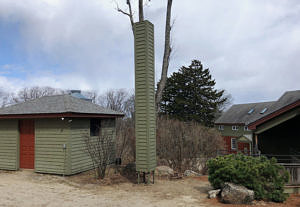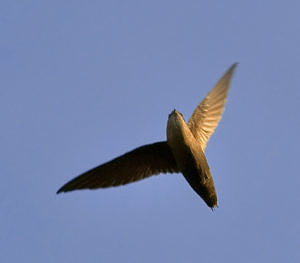Chimney Swifts are a bird whose very name alludes to their unique relationship with humans. Before European colonists arrived on North American soil, these masters of the skies nested in old hollow trees. As settlers spread out across the land, so did houses — and chimneys. From a swift’s perspective, chimneys serve the same function as dead snags, and the birds adopted them as nesting structures as early as 1672. During the colonial era, swifts flipped the familiar storyline of species decline at the hand of human settlement and actually expanded their range westward with the colonists (and their chimneys) into the treeless plains of North America. Over time, the birds’ use of natural cavities diminished. Like Purple Martins and Eastern Bluebirds, Chimney Swifts are now largely dependent on artificial structures for nesting.
A Species in Decline
Unfortunately, Chimney Swift populations have been on a steady downward trend for the last 40 years, with estimated declines of 50% caused in large part by loss of Amazon rain forest, where they spend the winter. However, in North America, the availability of suitable nesting sites is also declining. The conversion from wood and coal to oil and electric as energy sources has reduced the number of large urban chimneys, and changing building practices have rendered many residential chimneys unusable. From a swift’s perspective, every chimney lined with a metal flue and sealed with a wire grate is a lost nesting site.
The Harris Center building hosted at least two pairs of Chimney Swifts until it was renovated in 2002. Meade Cadot recounts being able to hear the nestlings every August, with their calls amplified through the wood stove, which acted like a loudspeaker. During construction, we lost one chimney and the remaining ones were capped. The Chimney Swifts never returned. We lost another couple of pairs in 2014 when we removed an abandoned house from a Peterborough conservation property.
Habitat Restoration in Hancock

The Harris Center’s new “chimney,” awaiting its first tenants. Click on the image for a larger view. (photo © Jeremy Wilson)
Amazonian deforestation is outside the scope of the Harris Center’s mission, but we can do something about habitat loss here in the Monadnock Region by re-provisioning swifts with suitable nesting habitat. In recent years, a bird house of sorts – resembling a freestanding chimney – has been designed for Chimney Swift use. Studies conducted elsewhere found that approximately 40% of these structures eventually attracted nesting swifts.
This spring, Carl Von Mertens and Hunt Dowse volunteered their time and expertise on behalf of the birds, and erected a Chimney Swift chimney in record time – ready for the birds’ anticipated arrival in late April. The next time you’re at the Harris Center, check out our newest “bird box,” just next to the shed in our upper parking lot. With any luck, it’ll soon have tenants!
Contact Us
For more information about the Harris Center’s Chimney Swift habitat restoration efforts, please contact Eric Masterson at (603) 525-3394 or by email.


